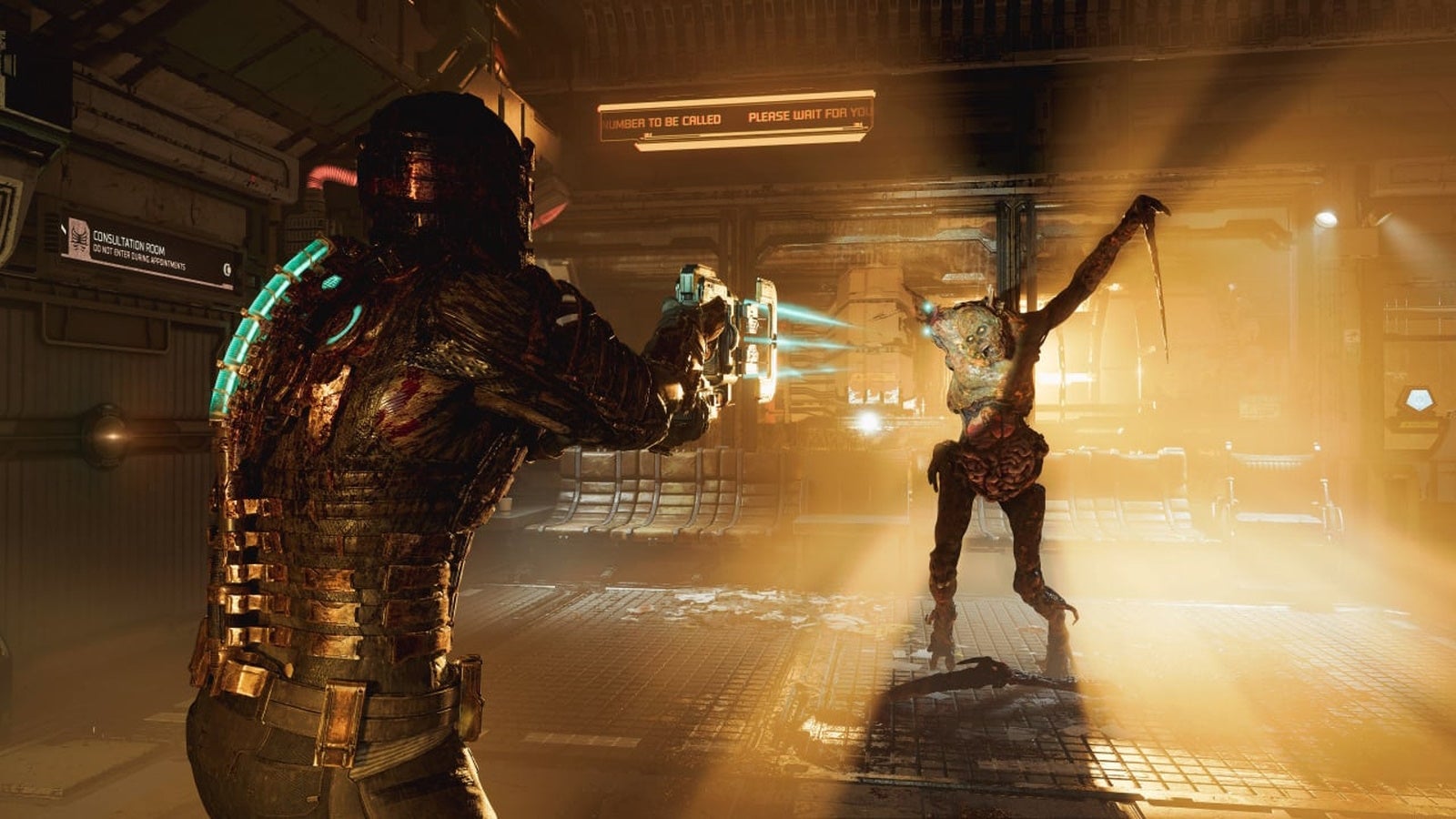Best PC controller 2022: the Digital Foundry buyer's guide to gamepads
The best first-party and third-party controllers tested - plus mobile gaming!
While PC gamers generally opt for a mouse and keyboard, millions of us also pick up a controller from time to time - and for good reason. In open-world games like Horizon Zero Dawn, controllers can offer a more comfortable way to play for long periods, while in racing titles like Forza Horizon 5 a gamepad can offer fine-grained analogue controls to steer around corners. If you fancy a little local co-op, plugging in a controller is a great way to do that too. But there are a ton of PC-compatible controllers on the market - which are actually worth buying?
The most obvious answer is that the best controller is the one you already have. This seems to be supported by stats released by Valve in 2018, which show the Xbox 360, Xbox One and PS4 controllers are the best represented amongst Steam users. However, are these gamepads necessarily the best options? In this article, we will answer that question by making our picks for the best PC gaming controllers on the market, including some you might not have considered.
As a little bonus, we're also recommending the best gamepads we've tested for iOS and Android.
How did we choose?
We used each of the controllers listed for at least two weeks - and in some cases, years - testing them in games like Horizon Zero Dawn, Forza Horizon 5 and Shadow of the Tomb Raider. We evaluated each gamepad in terms of its suitability for different PC gaming genres, its ease of use and its depth of features. We made one overall best pick that should suit most people, with additional picks for different criteria - like spending a lot or a little, gaming on titles that don't feature native controller support and gaming on both phones and PCs.
Note: Some ad blockers remove our 'where to buy' widget, so if you'd like to see pricing information please disable ad blockers for this page.
Scroll down to see the full round-up, or click the links below to skip ahead!
Table of contents
- Best PC controller: Xbox Wireless Controller
- Runner-up: Sony DualSense (PS5) Controller
- Best premium PC controller: Xbox Elite Series 2 Controller
- Best cheap controller for PC gaming: Xbox 360 Controller
- Best third-party PC controller: Razer Wolverine V2
- Runner-up third-party PC controller: Astro C40 TR
- Best small PC controller: Nacon Rig Pro Compact
- Most customisable PC controller: Scuf Instinct / Instinct Pro
- Runner-up customisable controller: Victrix Gambit
- Best controller for PC, iOS and Android: SteelSeries Stratus Duo
- Best MFi controller for iPhone and iPad: SteelSeries Nimbus+
- Best controller for Android: PowerA Moga XP5-X Plus
- Best of the rest: other controllers we tested
Best PC controller: Xbox Wireless Controller
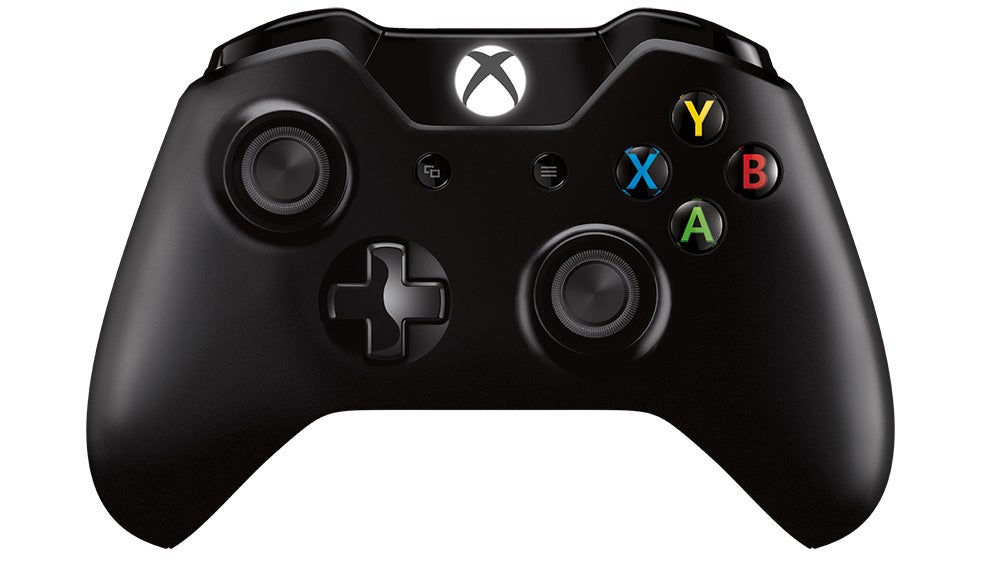
The best PC controller for most people is the Xbox Wireless Controller. This Xbox Series X/S era controller works well out of the box with the widest range of PC titles, offers wired, Bluetooth or 2.4GHz wireless connectivity and is available in a range of colours at a fairly reasonable price. The Microsoft controller is also well-made, with responsive triggers and a large, comfortable shape.
However, the controller does have its downsides. Rather than charging via a Micro USB cable, the Xbox Series controller takes AA batteries, requiring a £20/$25 Play and Charge Kit to support USB recharging. In addition, most PCs don't support Microsoft's low-latency 2.4GHz wireless out of the box, requiring a £20/$25 Wireless Adapter for wireless connectivity.
Pros
- Unparalleled support in PC games, without requiring third-party software
- Low-latency 2.4GHz wireless connection plus Bluetooth
- Available in a range of colours and styles
Cons
- Eats AA batteries by default, with a rechargeable battery sold separately
For a cheaper Xbox-oriented alternative that's wired only, consider the Turtle Beach Recon. It works well across a wide version of PC games and boasts a surprising number of features for a £50 controller, including a pair of remappable rear buttons, multiple modes, and textured grips. You also get convenient audio controls for anything you plug into the 3.5mm port, making it a savvy way of making a basic headset feel a lot more premium. If that mix of features sounds worthwhile, we'd recommend it over the standard Xbox controller - although giving up wireless is still tough!
Runner-up: Sony DualSense (PS5) Controller
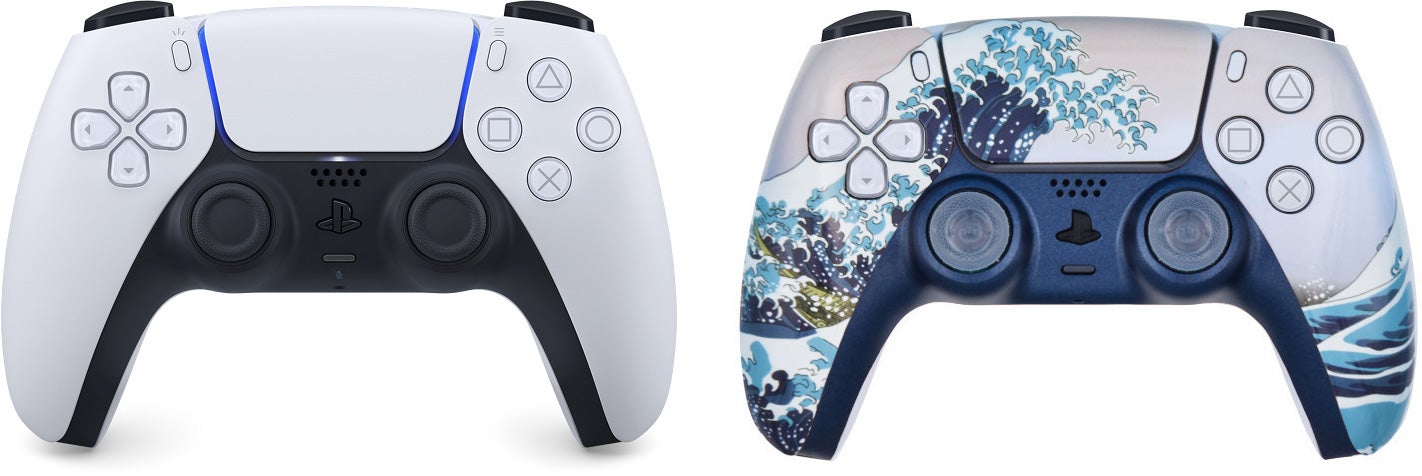
While the Xbox Wireless Controller is our top choice, the Sony DualSense PS5 controller is another worthy option. It has great triggers, its longer-than-DualShock design fits all but the smallest hands and of course it has that symmetric design some folks prefer. It's cheaper to run than the Xbox controller too, as it can be recharged via USB-C - so no need to invest in rechargeable batteries or keep buying non-rechargeable ones. There's even a gyroscope, which is useful for playing some emulated games, and first-party Sony games on PC offer the correct button prompts - even if most games will show the Xbox ones instead.
The only minor inconvenience is that you need to install third-party software to get the controller working on Windows. Thankfully, the DS4Windows software is free, easy to use and offers options not found on Xbox Accessories app. You can also use Steam's Big Picture mode, which supports the DualSense natively, for both Steam and non-Steam games.
The first custom PS5 controllers are also slowly becoming available, including from Scuf and MegaModz. We tested a custom DualSense controller from MegaModz with a custom shell, mechanical shoulder/face buttons, and interchangeable thumbsticks. The controller feels fantastic to use, thanks to those mechanical upgrades, and it's nice to see a PS5 controller that looks so different from the standard colour options too. Of course, custom controllers don't come cheap, but if you spend a lot of time playing controller-friendly games on PC and PS5 then it could well be worth the upgrade over the standard DualSense.
Pros
- Comfortable, high-quality controller with incredible triggers
- Doesn't require batteries or a dongle to work wirelessly
- Trackpad is convenient if your mouse isn't nearby
Cons
- Requires third-party driver installation to work well
- Button prompts often conflict with controller layout
- Expensive - but DualShock 4 is also available for less
Best premium PC controller: Xbox One Elite Series 2 Controller
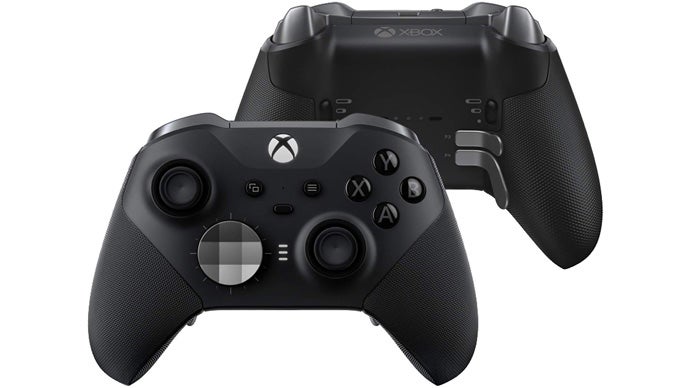
If you're willing to spend more on your controller, the Xbox One Elite Series 2 is the best controller we've tested thus far. Its controls are tight and responsive, with clicky face buttons and a generous grippy coating that ensures a great in-hand feel. There are plenty of customisation options too - you can add four paddles to the rear, swap out the sticks for four alternative options, adjust stick sensitivity and opt for a circular eight-way d-pad. The ability to toggle between three levels of trigger sensitivity with the flip of a switch is also impressive. There's even third-party software like ReWASD that lets you rebind the paddles to keyboard commands, if you want even deeper customisation, although the standard software is also more powerful than before.
The Series 2 also improves on its predecessor with a more modern design equivalent to the most recent standard Xbox One controller, including Bluetooth connectivity, a headphone jack and USB-C charging via the included stand or a USB-C cable. The rechargeable battery used here is arguably more convenient than the previous system that used AA batteries, but it's also not user replaceable. In total though, the generational changes here are overwhelmingly positive - and you can read more in our Elite Controller Series 2 review.
Sadly, the Series 2 has not had the cleanest launch, with some users facing quality control issues out of the box such as face buttons working intermittently or sticks drifting - not what you'd expect from a premium product. The Elite Series 2 is still good enough that we recommend it, but we'd encourage you to test it thoroughly after purchase and buy from a retailer with a solid return policy. Microsoft itself offers a warranty of 90 days in the US and Canada, or one year in the UK, so do take advantage of it if your unit develops any problems.
Pros
- Incredible levels of hardware and software customisation
- Comfortable, precise feel with excellent tactile feedback
- Includes creature comforts like Bluetooth and USB-C charging
Cons
- Durability issues are concerning for a high-end product
- Rechargeable battery isn't user replaceable
Best cheap controller for PC gaming: Xbox 360 Controller

The venerable Xbox 360 controller, particularly its wired iterations, offer one of the cheapest ways to enjoy console-style gaming on the PC. With both knockoff versions and plenty of used models on the market, it's easy to grab enough controllers for everyone. Modern DualShock 4 and Xbox One controllers feel better in the hand and are less likely to exhibit wear-and-tear, but if you're only an occasional gamepad user, this controller will do just fine and cost much less.
Pros
- Available used for bargain basement prices
- Widely supported by PC games
Cons
- Ergonomics and tactility doesn't match newer controllers
- Wireless models require Wireless Gaming Receiver for wireless connectivity on PC
Best third-party PC controller: Razer Wolverine V2

While Microsoft and Sony's long expertise with games consoles means that their controllers are the default option for many, there are also some great third-party alternatives worth considering. The Razer Wolverine V2 is one of the best options, thanks to its use of clicky and satisfying mechanical switches for face button, optional hair triggers and two extra buttons on the rear. It doesn't offer additional paddles, like the earlier Wolverine Tournament Edition, but it does offer a more comfortable shape. We played games like Tetris Effect for hours on this pad without issue - the only problem was that going back to a standard controller afterwards that lacked that tactile feedback is tough once you know what you're missing!
The controller can be customised in the Razer Controller Setup for Xbox app, available on Xbox and PC, where you can rebind the buttons and dial in the Wolverine's sensitivity. While the Wolverine V2 costs more than a standard first-party controller, it is still a significant upgrade that's well worth considering if you play a lot of gamepad-friendly PC games.
Pros
- Best software for remapping and customisation
- Well-constructed with tight, tactile and often clicky controls
Cons
- Expensive for a wired controller (although cheaper than the Wolverine TE)
- Lacks the metal components of the similarly-priced Xbox One Elite controller
Runner-up third-party PC controller: Astro C40 TR

Another excellent third-party option is the Astro C40 TR. This controller supports both Xbox-style and PlayStation-style thumbstick and d-pad placements, thanks to a semi-modular design, and also boasts a high level of fit and finish befitting its premium price. We particularly liked the inclusion of taller thumb sticks, which allow for a higher level of control after a short adjustment period. The two rear buttons here are also cleverly implemented, sitting naturally beneath your fingers with sufficient resistance to prevent accidental presses. Each can be bound to any other button in a matter of seconds, without the need to touch software or change profiles, which is a nice touch.
If you do dip into the software, you're in for a treat - there's plenty of settings to adjust here, from trigger sensitivity to stick dead zones, and the interface is intuitive enough that you won't mind setting up a new profile for your next game. Connectivity is handled via a 2.4GHz wireless USB dongle, with the option for a wired Micro USB connection if you'd prefer. Battery life was excellent in our testing, with the C40 TR only requiring a couple of top-ups in weeks of use. The package is completed with a hard case for the controller and its accessories. If you play on both PS4 and PC and you're willing to invest in a premium controller, this is a worthy choice.
Pros
- Well-constructed with responsive controls and clicky shoulder buttons
- Deep customisation and intuitive software
Cons
- Lacks the extra clicky face buttons of the Razer Wolverine
- Not guaranteed to work with the PlayStation 5
Best small PC controller: Nacon Rig Pro Compact

The Nacon Rig Pro Compact does exactly what it says on the tin, providing an Xbox-style controller that is more diminutive than the first-party models. This makes it a better choice for the significant percentage of the world's population that has smaller hands. Even the middle buttons - Menu, Select, Share - have been moved closer to extremities of the controller to make these oft-useful keys easier to press. The gamepad also comes with unusual short-throw triggers, which are great for shooters where the trigger is more or less a binary input and making it quicker to actuate could win a few battles, and not so great for racing games where you have less precise throttle and brake control. The Pro Compact feels relatively well made, and unlikely to break, but its light weight makes it almost feel a little hollow despite its robust exterior. This Nacon controller also comes with Dolby Atmos for Xbox and PC; just install and run the Dolby Atmos app from the Windows or Xbox store with a headset connected to get a free lifetime license (normally $15). There's also a Pro Compact app for both platforms that allows you to customise the button assignments, stick sensitivity, and so on. All in all, it's a convincing package given that it costs less than a standard Xbox controller.
Pros
- Conveniently compact frame for the small-handed
- Dolby Atmos for Headphones license included for Xbox and PC
- Short-throw triggers (good for shootin')
Cons
- Wired only (no wireless)
- Menu button dangerously close to face buttons
- Short-throw triggers (not so good for driving)
Most customisable PC controller: Scuf Instinct / Instinct Pro

The Scuf Instinct and Scuf Instinct Pro are deeply customisable controllers for Xbox consoles and PC. I opted for a controller with an interesting topographical map theme in blue and gold, matching this with mono-colour face buttons, black sticks, and grey d-pad, shoulder buttons and triggers. There are tons of options here, with eleven elements you can tweak - including less cosmetic changes like ripping out the rumble motors for a lighter gamepad or opting for different shape sticks. (Scuf's earlier Xbox One era Prestige controller has even more colour options - the firm assured me that the Instinct series will have a similar number of options eventually). The Pro adds rubber grips and four rear buttons - fittingly, features that may prove handy for high-level play but are easily dispensed with to save some money on what is already an expensive proposition.
The Instinct series use the same circuit board as Microsoft's controllers and pair in the same way, so on PC you can use them wired via USB-C, via Bluetooth or via lower-latency Xbox Wireless with an Xbox Wireless Adapter dongle. It also means they benefit to Microsoft's latency improvements and can even be upgraded with new firmware as it's released. Both Instinct gamepads also feature three profiles, allowing you to customise the controller on a per-game basis by tapping a button, and a button for muting the headset.
Compared to the similarly expensive Xbox Elite Series 2 controller, it's hard to pick a favourite. The Elite Series 2 feels more substantial in the hand, with clickier buttons and more conveniently placed triggers, but the Instinct Pro is lighter, with even shorter-throw triggers and a smoother chassis. I think I would normally come down for the Elite Series 2, but that controller's reliability woes would give me some pause - and the Instinct Pro's customisable look makes it a distinct option in its own right.
Pros
- Can be customised for a look and feel entirely your own
- Instinct Pro variant offers hair triggers and extra grip
- Works just like the official Xbox Series X/S controller
Cons
- Extremely expensive once fully customised
- Face buttons and d-pad aren't quite as good as the best controllers from Microsoft or Razer
Runner-up customisable controller: Victrix Gambit
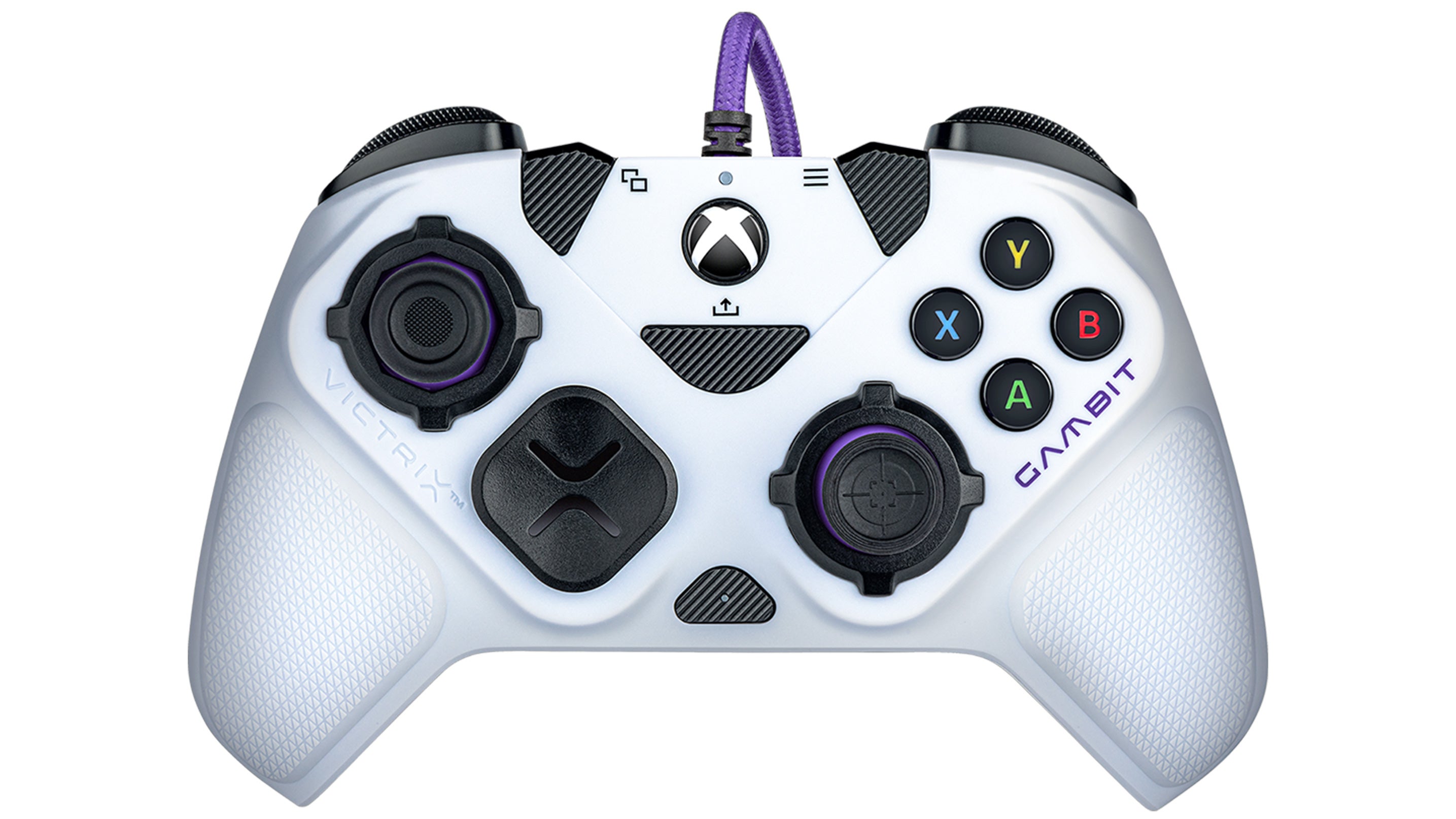
The Victrix Gambit is another nice option if you prefer a controller you can make your own, with some novel post-purchase customisation ideas. There's a choice of top plates, including a rubbery option for silent play, and circular or octagonal rings for each thumb stick. More standard are the offered d-pads (eight-way or four-way), thumb sticks (short or long), rear paddles (two or four) and the provided carry case. Each change I made had an obvious effect, and I was particularly impressed with the rubber top plate. The build quality here is excellent too, with satisfyingly smooth triggers and slightly tactile face buttons, although the placement of the start and select buttons takes a little getting used to. This is a wired controller only, which is in my view totally fine for PC play but less suitable for gaming on the sofa. The cable is at least relatively soft and flexible, unlike some other controllers I've tried recently. Finally, Victrix boasts of a dual-core design that delegates input and audio to separate cores, reducing input latency, but I don't have the means to test this and the controller didn't feel noticeably better or worse than alternative options. I think there's enough here to justify the £100/$100 asking price, and I'll be keeping the Gambit on my desk to play Forza Horizon 5 for a while longer!
Pros
- Excellent range of customisation options included
- Good build quality makes the controller a pleasure to use
- Works just like the official Xbox Series X/S controller
Cons
- Layout of some less-used buttons is unorthodox
- Cool transparent body is hidden by the top plates
- No wireless connectivity
Best controller for PC, iOS and Android: SteelSeries Stratus Duo
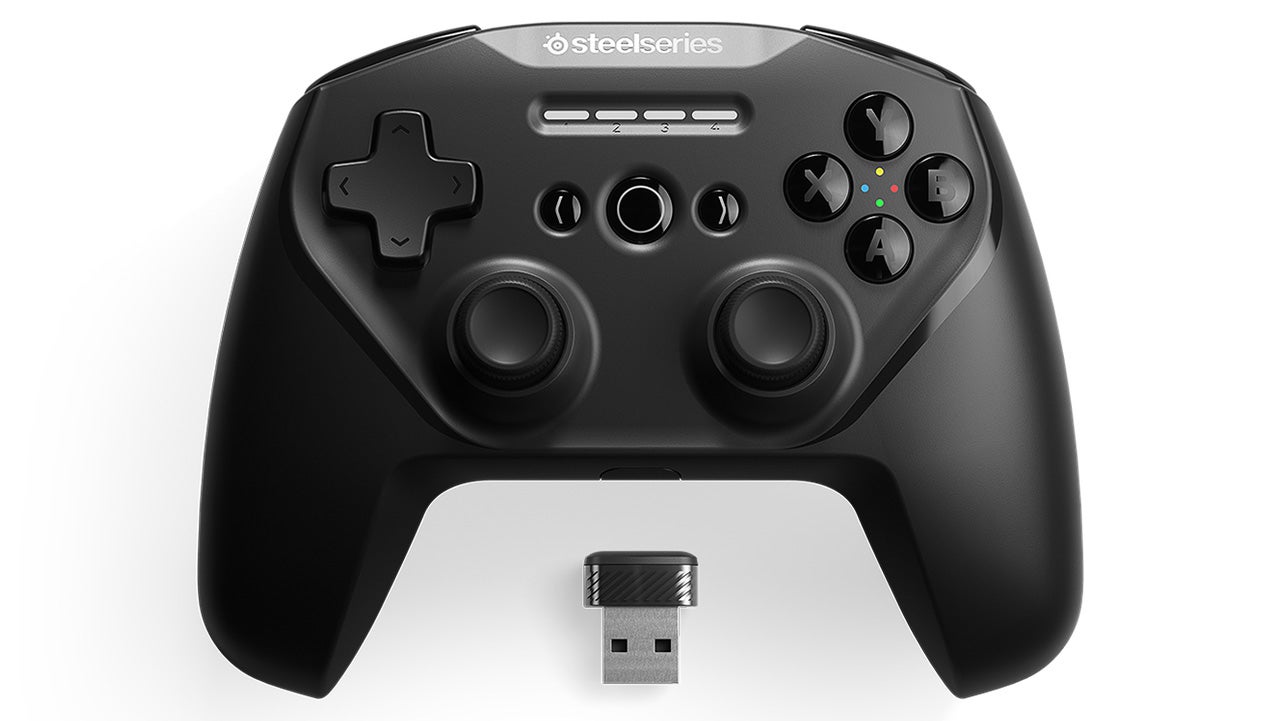
The SteelSeries Stratus Duo is another clever controller; this time it's all about supporting multiple platforms. As well as connecting to PCs via a 2.4GHz USB dongle, the Stratus Duo can also connect to Bluetooth devices like phones and tablets when a switch is flicked on the back of the unit. Battery life is lower when you're using Bluetooth mode, but given your phone is best-suited for short play sessions, this isn't a massive concern. The Stratus Duo works on both iOS and Android, but it is worth remembering that not all games support gamepads natively. However, for playing Fortnite or an emulated SNES title, the Stratus Duo works great. While the controller's build quality seems sound and the controls feel accurate, the button layout isn't ideal - I found it tricky to tap the middle buttons without getting tangled up in the thumb sticks. It's also disappointing that the SmartGrip accessory for actually mounting the controller to your phone is a $10/£10 optional add-on - for the price, it really ought to be in the box.
Pros
- Can connect via 2.4Ghz wireless (PC) or Bluetooth (mobile)
- Good option for mobile VR gaming
Cons
- SmartGrip accessory for mounting onto your phone costs $10
- Relatively short battery life on Bluetooth
Best MFi controller for iPhone and iPad: SteelSeries Nimbus+
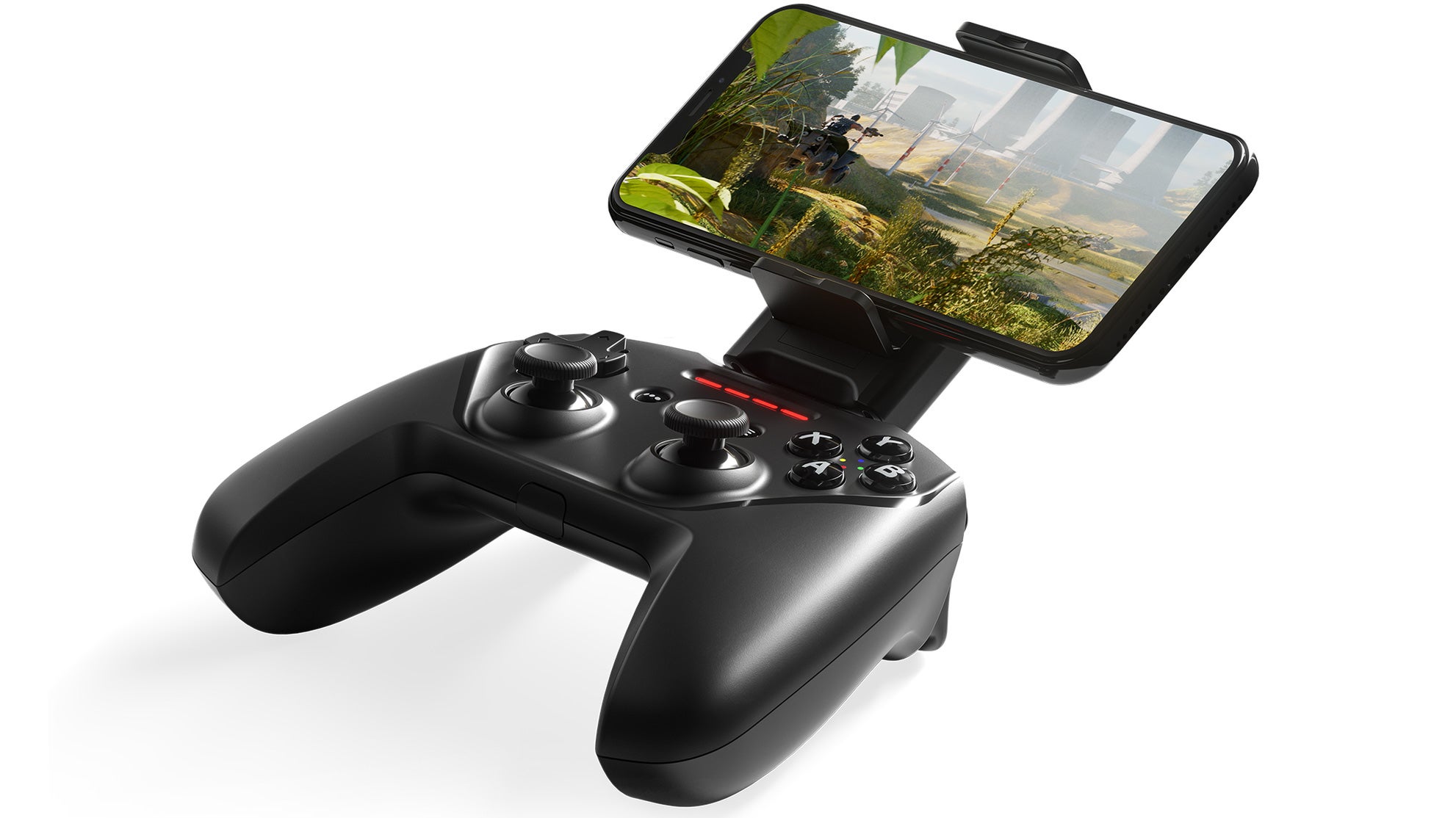
The SteelSeries Nimbus+ lacks the cross-platform capabilities of the Stratus we highlighted earlier, but offers Lightning charging (the same as the iPhone) and a larger and more comfortable size. That makes it the better bet if you don't need Android support. It also includes an iPhone clip in the box, something we dragged the Stratus for not doing. However, the jaws here don't expand far enough to accommodate the iPad Mini, so we'd recommend opting for a case with a kickstand or a dedicated stand if you want to use the Stratus+ with an iPad. The Nimbus+ is a pleasure to use too, with a lovely clicky d-pad, tactile buttons and clickable thumbsticks. If you want to make the most of the surprisingly expansive library of iOS games on the App Store and Apple Arcade, the Nimbus+ is a great choice at a price that's only a hair over a standard console gamepad.
Pros
- Tactile and responsive d-pad and buttons
- Convenient iPhone clip is included in the box
Cons
- Relatively large size means this isn't the most portable option
Best controller for Android: PowerA Moga XP5-X Plus
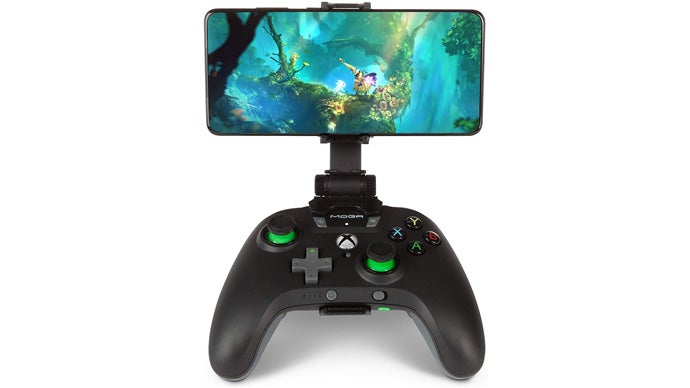
The PowerA Moga XP5-X Plus is one of the best controllers for Android we've ever used, thanks to its surprisingly high build quality, convenient clip-on form factor and clever built-in 3000mAh portable charger. Gaming on mobile does hit the battery hard, so it's great to see a built-in way of ameliorating this disadvantage. The tactility of the controller is reasonable too, although it doesn't quite match the feel of a new Xbox or PlayStation gamepad - there's a little softness in the d-pad and the face buttons. Still, for the money you're paying, the overall experience is high quality.
Unfortunately, support for wired controllers in native Android games can be hit or miss, with Bluetooth gamepads like the Xbox One controller seemingly being supported in a greater number of games. It's worth researching your favourite titles online before pulling the trigger if it's these native games that are motivating you to consider a gamepad. Still, for the games that support it, the Moga XP5-X offers a big improvement to tactility and control.
As an alternative, consider the Razer Kishi. It offers a different form factor, clipping around your phone to resemble an oversize Nintendo Switch. There are a lot of clever touches here, like a USB-C pass-through port that allows for charging and gaming at the same time, plus a wide frame that accommodates all but the very largest mobiles like the Samsung Galaxy S20 Ultra. However, the spongey buttons aren't up to Razer's usual tip-top standards, costing this option the top slot.
Pros
- Comfortable form factor for mobile gaming
- Being able to charge your phone while gaming is a nice touch
- Extremely useful in emulators, cloud gaming and supported Android games
Cons
- Finding the perfect balance point for your phone
- Not exactly a pocketable option, although it's portable enough
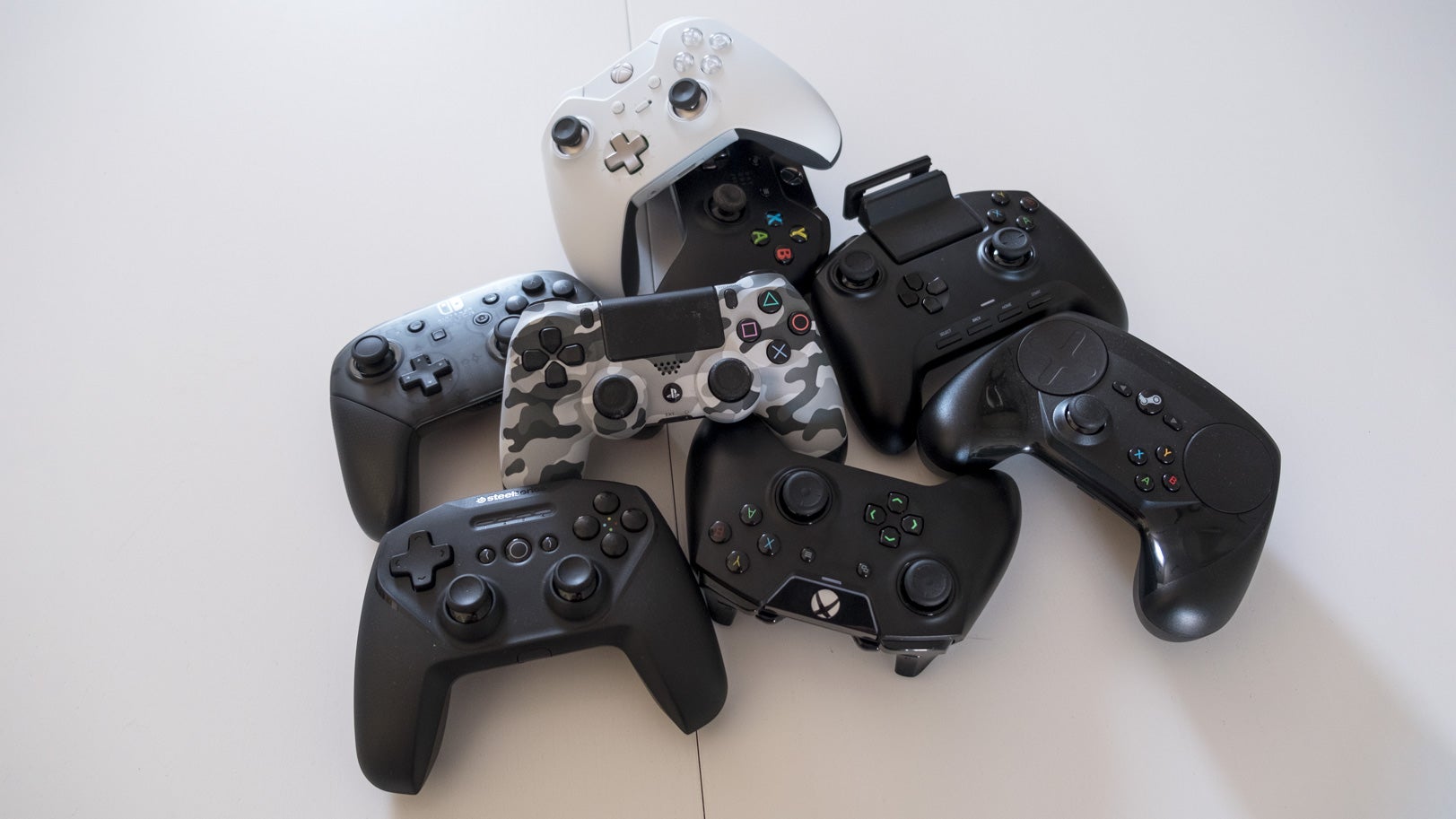
Best of the rest: other controllers we tested
To keep our recommendations manageable, we've opted for eight controller suggestions in the main article above. Here are some brief thoughts on the other controllers we've tested, including a few options that nearly made it into the top eight.
PowerA Spectra Enhanced Wired Xbox One Controller: At £30, this gamepad is about £15 cheaper than the official Microsoft Xbox One controller. You lose out on wireless connectivity and a tiny bit of build quality, but you gain edge and button lighting in seven colours, two programmable rear buttons and three-tier trigger locks. The trigger locks didn't work perfectly in our testing, with the most restrictive setting on both triggers resulting in different amounts of movement, but otherwise the controller delivers a reasonable gaming experience and looks good doing it. If the extra features are worthwhile for you and you're not interested in wireless connectivity, then this is a decent choice.
Thrustmaster eSwap Pro: Another solid take on the modular controller concept, this controller only barely misses out on a full place on our round-up. While the clicky buttons and tool-free hot-swappable modules are exceptional, the small rear buttons are harder to use than those of the Astro C40 TR and there's no option for wireless connectivity or hair triggers. Still, given its lower price than the C40 TR, it's worth considering.
Nintendo Switch Pro Controller: This is a good first-party controller with excellent battery life, but it is more expensive than its competitors and doesn't offer any compelling unique features beyond Switch compatibility and a cool see-through design.
Razer Raiju Mobile: While the Raiju Mobile sports clicky buttons, good ergonomics and a built-in smartphone clip, its unusual default bindings on PC require manual remapping in each game. By contrast, the SteelSeries Stratus Duo works well on PC out of the box.
Microsoft Elite Controller (Series 1): The first-gen Elite was a great controller, but the Elite Series 2 offers more features and a better tactile feel at the same price. Only consider this one if you can find it in working order at a good price, or if the lack of a user-replaceable battery in the Series 2 is a deal-breaker for you.
Nacon Pro Controller 3: The design and build quality of this controller is subpar, with flabby shoulder buttons and lethargic sticks, but the real issue is the placement of the extra buttons. Rather than paddles, Nacon has opted for a quartet of small buttons built into the lower grips. This is convenient, in that you can reach these buttons comfortably, but they're all-too-easy to set off accidentally and hard to differentiate. That makes the NPC3 a hard sell in a competitive premium controller market.
Razer Wildcat: Razer's previous-generation Xbox controller is hard to find new, but it can still be a decent choice if you can find it used for a good price. However, the Razer Wolverine offers better ergonomics and a more stylish design.
So, there you have it. We will continue to evaluate new gamepads and controllers to keep our recommendations up to date, and we welcome your feedback in the comments below.






